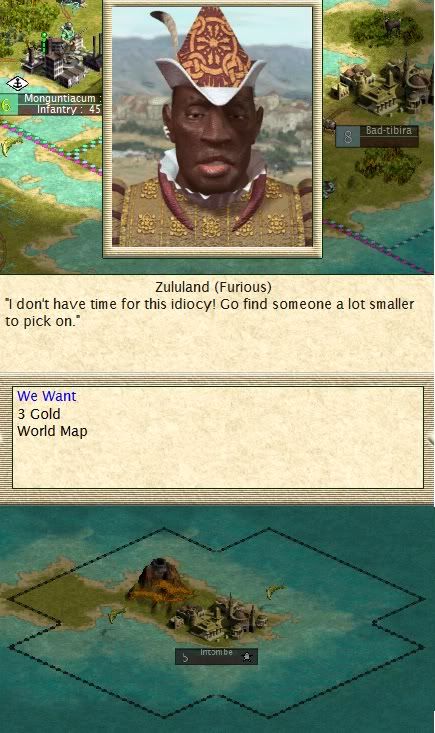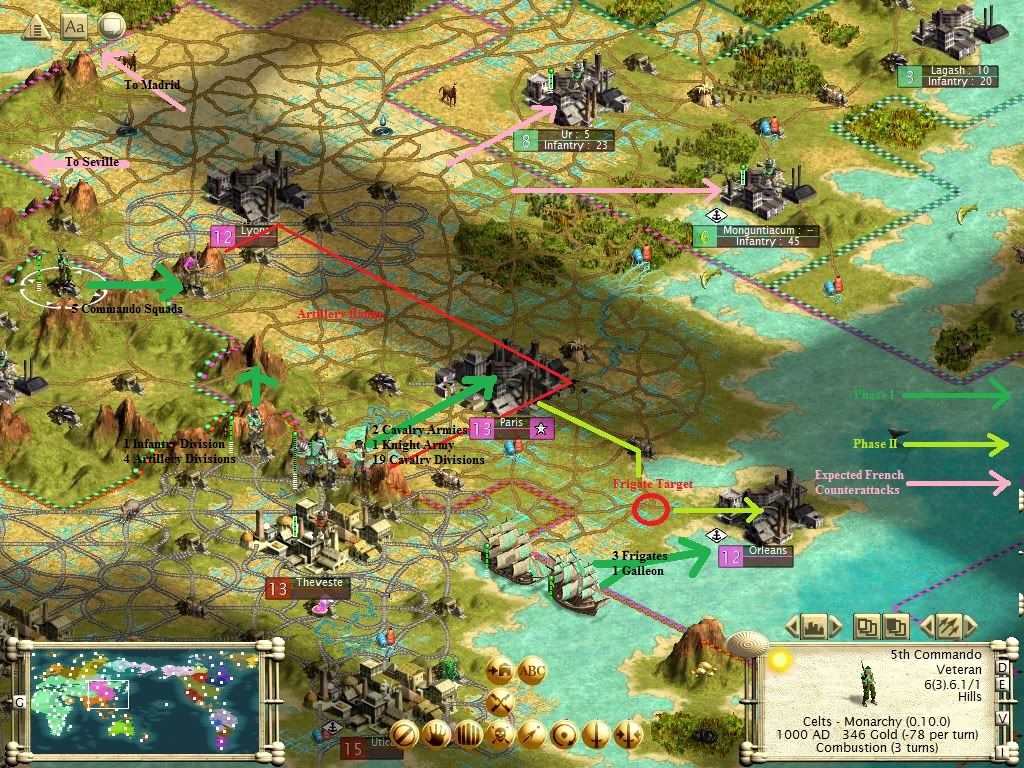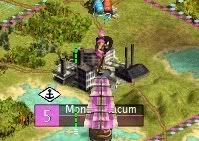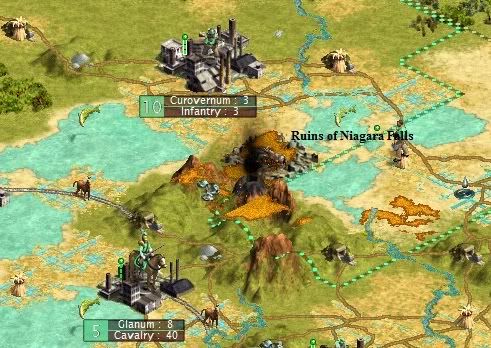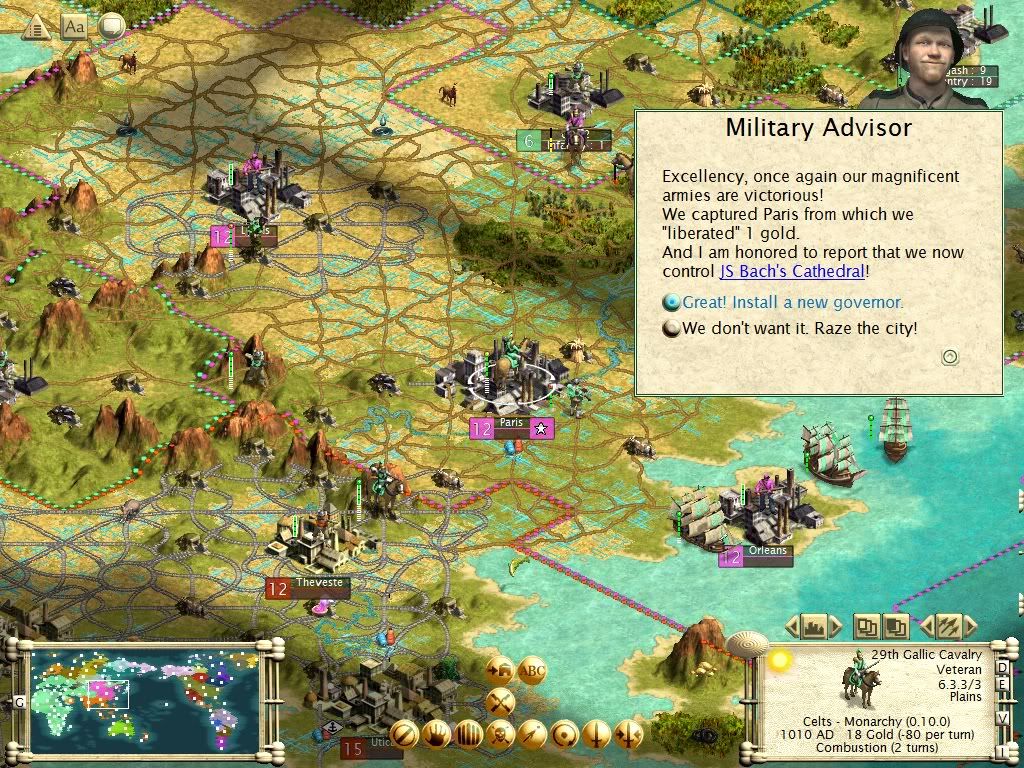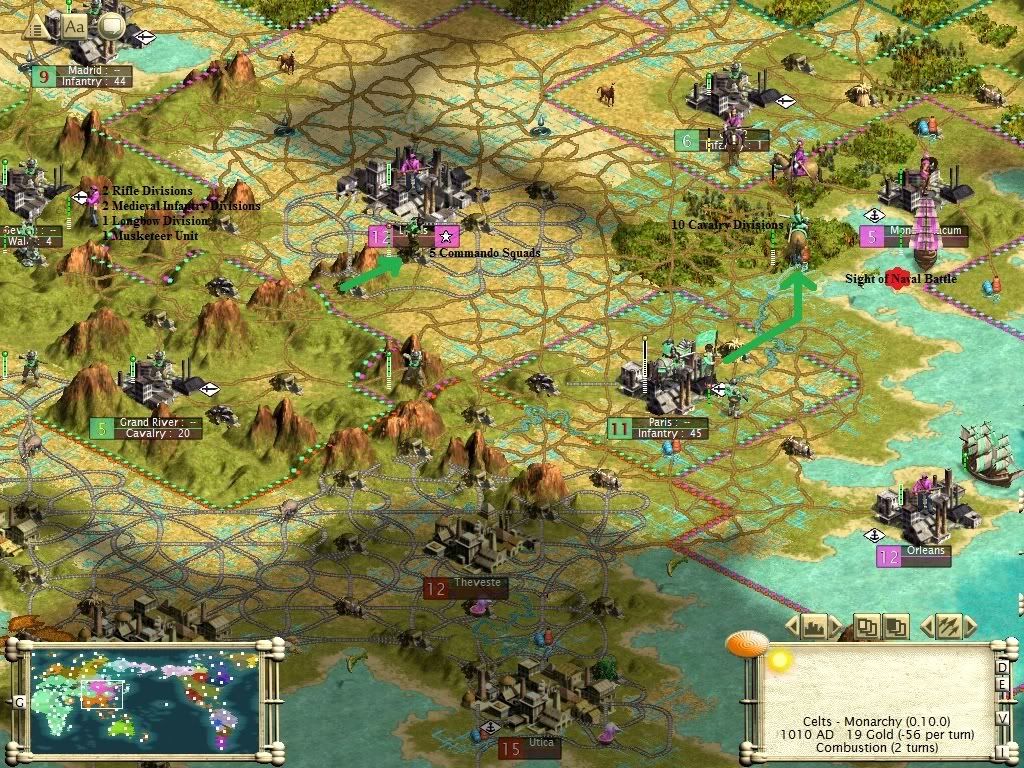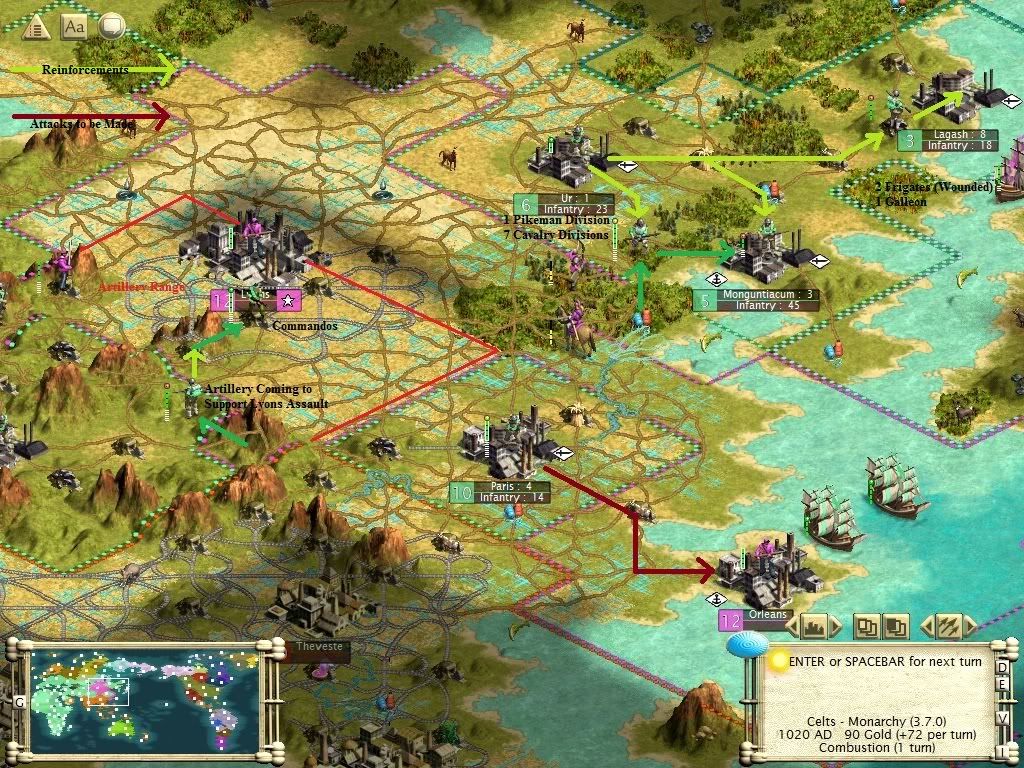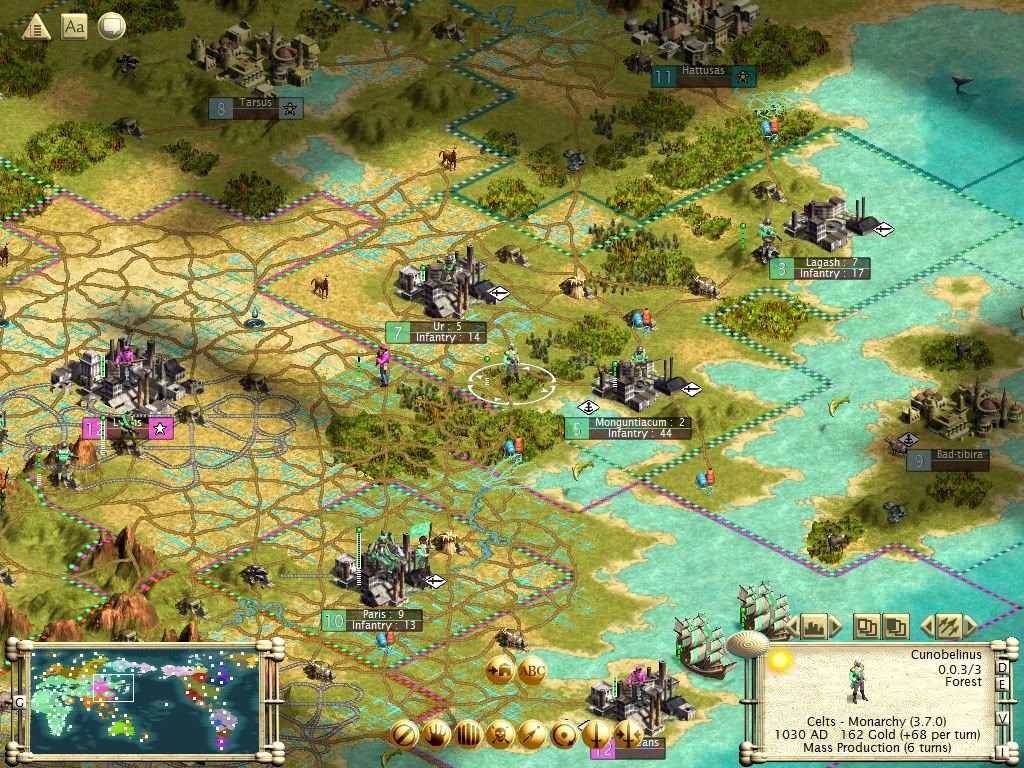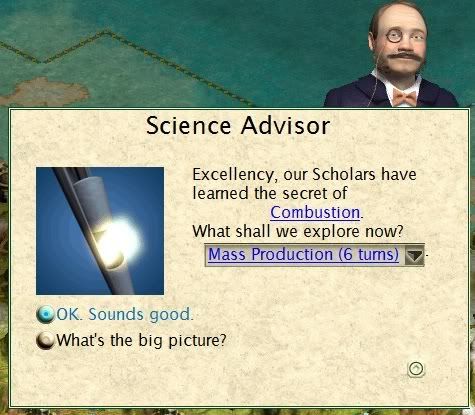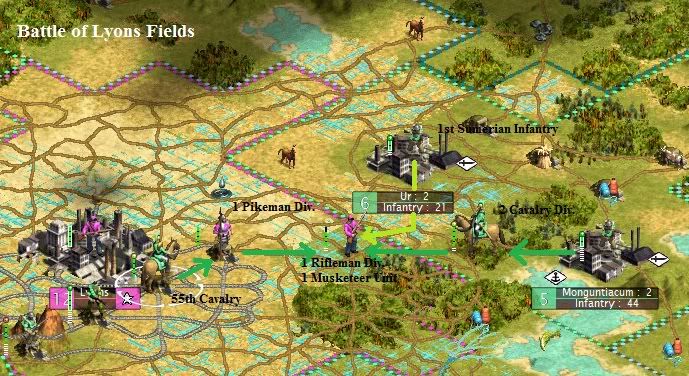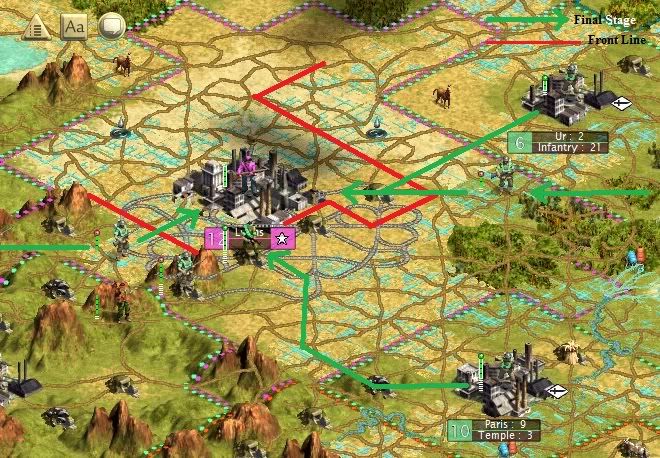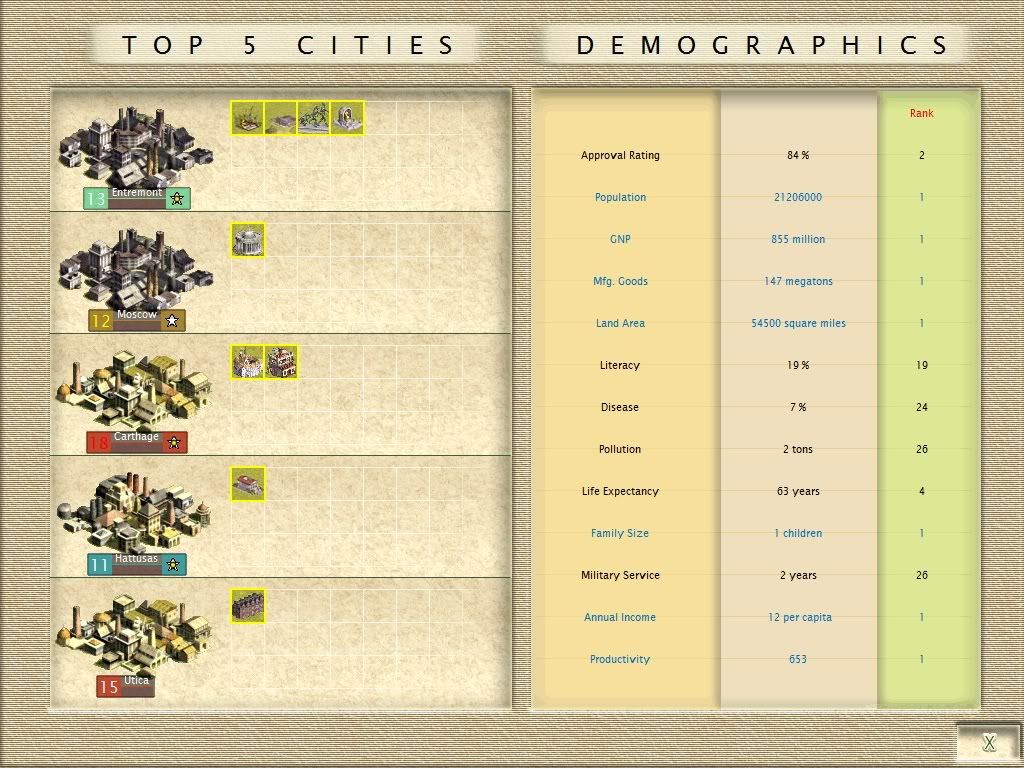Or not 'today'. Once again, the RL-bug strikes.

But I have driven it back and I give you...
Chapter XIII: Military Reform and the Beginning of the Franco-Celtic War
In the year 937 AD, the French and Zulu signed a historic deal. Their agreement guaranteed both sides that if one of them was attacked, it would be treated as an attack on both of them. Previous alliances between nations gave only a hope of technological and economic assistance where this Mutual Protection Pact secured military assistance.
Other nations discussed such alliances between themselves, though none of them had any results. The Celts themselves were approached by several nations with these offers, but none of them favored the Celts.
********************
Shortly after the Scientific Revolution ended with the death of Charles Darwin in 951 AD, the Royal Celtic Army completed construction on a military headquarters in Lugdunum. The building was called The Pentagon for its shape. In it was the command center for the actual armies of the Celts. At the time, the Celts had three armies. All of them were assigned an additional Cavalry Division to assist with future conflicts.
********************
In 989 AD, the Mt. Niagara Volcano went active. It was the first time that a Volcano had gone active in the world since the late 3rd Millennium BC. Geologists flocked to the area as lava spurted out of the mountains top. Fearing a full scale eruption like the one 4000 years before, the Celtic Government ordered that the city be evacuated. However, few people heeded this advice as the mini-eruptions became more frequent.
********************
The last decade of the 1st Millennium AD saw the introduction of a new political ideology into the Celtic lands. This new ideology was Communism. The Royal Domestic Intelligence Corps was dispatched to the Grand River area to trace this new ideology to its source. It was eventually discovered to have come from France. This disturbed the Celts. The French had long been an ally or at least a friend, were they turning against the Celts? Fearing an attack, the Celts moved the bulk of their army to Great Falls. Then, with the Carthaginian Senates approval, moved the Army to the Franco-Punic Border. The Celts then officially ended the Right of Passage that had been signed with the French several centuries earlier, when the Celts had invaded the Sumerian homeland to end their long war. Relations would deteriorate greatly over the next 8 years.
********************
At the turn of the millennium the French situation turned worse. During a French Senate meeting, a Celtic diplomat heard President Joan of Arc state:
Someone needs to tell Brennus to TAKE. HIS. MEDICINE.
Reporting back to Entremont, the agent was ordered to give the French a three word message as well, This is War.
********************
Knowing that war with Zululand was imminent, the Celts demanded under the threat of force, the entire pitiful Zulu treasury. The Zulu refused, and stupidly boasted of a larger empire than their island nation in the middle of the ocean. The Celtic diplomats laughed all the way home.
********************
Plans were brought from The Pentagon to the Royal Palace shortly after the Celtic-Zulu diplomats returned home.
A large force of 31,000 mounted Celts would ride to take Paris while another strike force was assembled in Africa. Meanwhile, the bulk of the Celtic Special Ops force would move east to capture a French labor division, then north to besiege Lyons. All of this was to be supported by four artillery groups. The artillery could assist in a second assault on Paris, damage French reinforcements, or destroy a French assault on the Celtic city of Grand River. During all of this the Celtic Fleet would attempt to hinder the French forces at Orleans, the only French port.
The Celts also expected several French counteroffensives to take place. They expected their Sumerian and Spanish cities to come under attack during the next several years. It wasnt known how many forces the French would be able to mobilize to launch on the attack. The Celts expected to lose at least one of the French target cities, it was just a matter of which one it would be.
********************
The attack on the French laborers succeeded without a single loss as the entire group surrendered together. This action however, caused the Zulu to declare war on the Celts because of their Mutual Protection pact signed some 50 years earlier, but the Celts did not fear the tiny island nation.
Fortunately for the French, the Celtic 1st Fleets bombardment of the Orleans Road failed miserably as there was no apparent damage to the road network connecting the city to the rest of France. Hoping to hinder the French war effort, the Celtic military leaders in Asia ordered the Main Celtic Army to attack Paris.
Attacking an enemys capital had proved a successful tactic in the past Celtic wars. Each of these historic battles had been quick victories, with the sole exception of the Battle of Thebes during the First Celtic-Egyptian War. The Celtic Army rode towards Paris, crossing the River Seine within two days. By the end of the third week of the war the Celtic Army was assembled on the plains outside of the city. The Celts brought their entire army to face the French Army that lined up opposite of the Celtic lines. Celtic Forces included 28,000 Cavalry and 3,000 Knights, while the French army included a mixed assortment of Riflemen, Longbowmen, Medieval Infantry, Pikemen, and Cavalry numbering over 18,000 men.
The battle began poorly for the Celts. Using their three main armies, the Celts attacked viciously. But despite their numbers, the Celts werent able to strike a crushing blow to the French Army, losing 6,000 men in the process. Pulling back their primary forces, the Celtic generals ordered a massive charge with 18,000 cavalry. The fight on the flank went extremely well for the Celts, where the French had positioned their outdated troops. The rifles of the Celts hammered the French Pikemen and Medieval Infantry. But the fight against the French Riflemen was a disaster. The Celts lost over 10,000 men to the French Rifles, while the battle on the flank only cost 500 lives. Fearing a total defeat, the Celts pulled back to their camp to wait for reinforcements.
********************
As the Celts pulled back, the French went on the offensive. Moving rapidly northeast, the French eventually defeated a division of Infantry outside of the City of Ur. Seeing that Monguntincum was even weaker than Ur, the French then moved their cavalry outside of the city to attack. The next day, the single division of Infantry in the city prepared for battle, moving their machine guns outside of the city where they could be used against the French cavalry as they came out of the Forest of Gilgamesh.
The French stormed the city recklessly. Wave after wave of cavalry washed over the defenders, but the French could not breach the front lines. In a final assault, the French sent in their last, battered Cavalry division that had been taken from Paris to launch their attack. Unbelievably, the Celtic machine guns jammed and the Celts were forced to abandon them as they fled. Seizing the guns, the French stormed into the city where the Celts made a last, desperate attempt to save the city, before they were finally overwhelmed. Celebrating their victory, the French moved in their Ceremonial Guard, which was armed with spears and shields. This loss humiliated the Celts, and they vowed to destroy the French.
But the French continued to advance, moving an Army of 6,000 outside of Seville, Celtica.
********************
The Celtic morale was hurt even more when Mt. Niagara finally erupted in 1009 AD. The city of Niagara Falls was incinerated along with over 50,000 Celtic citizens. Joining the Celts in mourning this loss was the Iroquois who had founded the city several thousand years earlier without knowledge of the looming volcano nearby. As a result, the tensions between the two nations finally began to ease.
********************
In 1011 AD, the Celtic Army was refreshed. Over the past ten years, some 12,000 Cavalry had been trained in Africa and shipped by rail to the same staging ground that the Celts had used earlier, before the Franco-Celtic War began. As the reinforcements neared, the Celtic Army outside of Paris was rallied by General Vercingetorix I. Hoping to capture the city without reinforcements; the Celtic Army was supported by a massive bombardment of Paris. Over 1000 French Riflemen were killed, the rest assembled outside of the city, looking for a repeat of the last battle.
The Parisians were overconfident, however; and the Celtic Cavalry ripped apart their lines. Celtic forces lost only several hundred Cavalry as the French 2,000 Riflemen were decimated. President Joan of Arc fled Paris as the Celts closed on the National Palace. Under fire from artillery, she and the government fled north, to Lyons, where they would establish their new capital.
During the capture of Paris, the Celtic Army discovered an ancient French text called
The Art of War. The text described how to wage war effectively against a foe. As to why the French had not used the texts great wisdom in battle, the Celts did not know. But this great work of literature and strategy quickly spread throughout all of Celtica. The people of all the cities were inspired, and together built Barracks for training soldiers in every mainland Celtic city.
********************
During the French counter attacks, the Celtic border patrol was in very poor condition. An entire division of Cavalry slipped through the border and charged towards the undefended cities of Celtic Europe. Seeing a last opportunity to stop a disaster from occurring, the 2,000 Knights and Heavy Cavalry that were stationed in Seville charged out to meet them in battle. Using the railroad system to catch up to the French Cavalry, the Celts engaged the French. In a pitched battle the Celts managed to wipe out the intruding Cavalry, but at the loss of over 75% of their men. Fortunately, the French were disheartened by their defeat in the Battle of the Plains and did not send any more such incursions into Celtica for a number of years.
********************
Another strike against the French came as the Celtic Fleet set out in pursuit of a French naval force. Once they caught up however, the French were ready. The Celtic ships engaged the French Frigates, but despite dealing heavy damage to the French, the Celts were defeated. Humiliated, the Celtic Naval Command vowed never to build another Frigate. From now on, they would use only modern ships, and set about designing a series of Oil-powered vessels.
********************
After the Celtic campaigns, they stood ready to retake Monguntincum. The Second Battle of Paris had been a great success, and despite the loss of the 1st Fleet, hoped to use their momentum to deal a crushing blow to the French.
********************
Fears that King Brennus had possessed of having the French retake Paris proved unfounded as the French attacked the army of 10,000 Cavalry south of Monguntincum. The French were pushed back at minimal losses for the Celts.
The French also had great fears of the Celts and in 1018 AD, pulled back their army from Seville to defend against an expected Celtic assault against Lyons. However, the Celts had no such plans to fight the French in the northwest.
********************
After suffering minimal losses against the French in the First Battle of Monguntincum Woods, the Celts pressed north to the outskirts of the city. The French had also failed to pull back their Ceremonial Guard, and the 1000 Spearmen were forced to take to the field of battle. A bloody brawl ensued when the Celtic Cavalry were pulled into the French lines. But ultimately, the Celts were victorious and the city was reclaimed as the vultures picked at the carcasses of the former French Ceremonial Guard.
Roughly half of the Celtic Cavalry forces remained outside of the city to defend against the expected French counterattack. The 22nd Pikemen Division was recalled into action from their barracks in Ur to help defend. These Pikemen were among the last of their kind, and were considered to be Elite at stopping Cavalry charges.
Celtic reinforcements also went to Lagesh to help defend against a potential French attack there.
********************
The Second Battle of Monguntincum Woods was a great struggle. Neither side expected the level of carnage that was to occur there. Thousands of troops were involved on both sides. The battle began with French Cavalry assaults which were driven back by the Pikemen at heavy costs, among them was their commander, Cunobelinus. As their formation dissolved, he stayed back, killing dozens of French Cavalry in the process. The result of his bravery was his promotion to Field Marshall. Eventually, the 22nd Pikemen was effectively destroyed, but the Celtic Cavalry, some fighting at half strength after their costly battle with the French beforehand, held back multiple charges by Riflemen, Musketeers, and Medieval Infantry.
********************
Several years after the defeat of the Celtic 1st Fleet, the Naval Engineers were able to produce a combustion engine. These engines were made increasingly valuable on both land and at sea as they were used to power the first-ever automobiles and the massive Celtic Cruisers and Destroyers. Soon, Celtic Seaports at Delhi and Entremont were producing these engines for the soon to be massive Celtic Navy.
********************
The Battle of Orleans was a very straightforward battle. Charging up a peninsula, the Celts crushed the 4,000 man force defending the city, suffering only 1500 casualties in the process. But it was a great victory for the Celts as it reduced the French Empire to a single city. Looking forward, the Celts prepared to take that last city. But first, the French Field Army had to be destroyed
********************
After the fall of Orleans, the Celts attacked the last of the French field armies in the Fields of Lyons campaign. The campaign was started by a Celtic Cavalry division smashing a Pikemen Division southwest of Lyons. This was followed by the great victory over the remnant of the French Army that had attacked the Celts in the Second Battle of Monguntincum Woods. The Celts lost only 1500 men while the French lost almost twice that number. Momentum favored the Celts as they readied for a final push to destroy the French.



 Stupid service hours
Stupid service hours






![Party [party] [party]](/images/smilies/partytime.gif) .
. 






